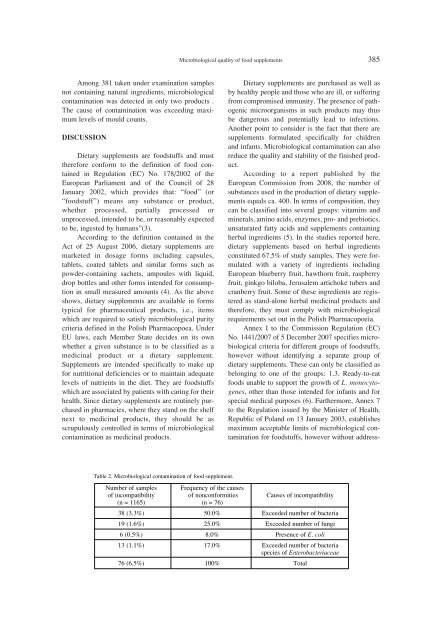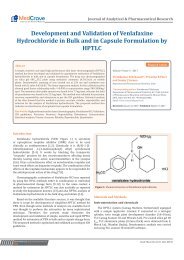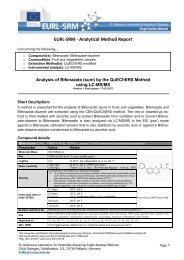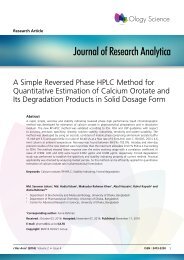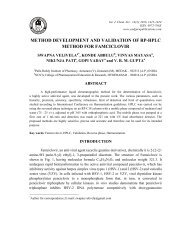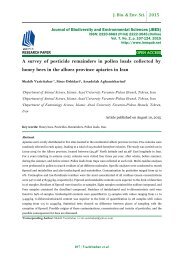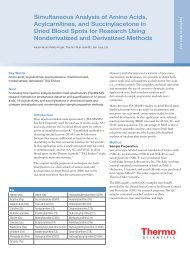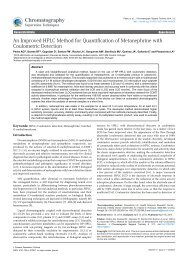acta 2_2015
acta 2_2015
acta 2_2015
- No tags were found...
You also want an ePaper? Increase the reach of your titles
YUMPU automatically turns print PDFs into web optimized ePapers that Google loves.
Microbiological quality of food supplements 385Among 381 taken under examination samplesnot containing natural ingredients, microbiologicalcontamination was detected in only two products .The cause of contamination was exceeding maximumlevels of mould counts.DISCUSSIONDietary supplements are foodstuffs and musttherefore conform to the definition of food containedin Regulation (EC) No. 178/2002 of theEuropean Parliament and of the Council of 28January 2002, which provides that: ìfoodî (orìfoodstuffî) means any substance or product,whether processed, partially processed orunprocessed, intended to be, or reasonably expectedto be, ingested by humansî(3).According to the definition contained in theAct of 25 August 2006, dietary supplements aremarketed in dosage forms including capsules,tablets, coated tablets and similar forms such aspowder-containing sachets, ampoules with liquid,drop bottles and other forms intended for consumptionin small measured amounts (4). As the aboveshows, dietary supplements are available in formstypical for pharmaceutical products, i.e., itemswhich are required to satisfy microbiological puritycriteria defined in the Polish Pharmacopoea. UnderEU laws, each Member State decides on its ownwhether a given substance is to be classified as amedicinal product or a dietary supplement.Supplements are intended specifically to make upfor nutritional deficiencies or to maintain adequatelevels of nutrients in the diet. They are foodstuffswhich are associated by patients with caring for theirhealth. Since dietary supplements are routinely purchasedin pharmacies, where they stand on the shelfnext to medicinal products, they should be asscrupulously controlled in terms of microbiologicalcontamination as medicinal products.Dietary supplements are purchased as well asby healthy people and those who are ill, or sufferingfrom compromised immunity. The presence of pathogenicmicroorganisms in such products may thusbe dangerous and potentially lead to infections.Another point to consider is the fact that there aresupplements formulated specifically for childrenand infants. Microbiological contamination can alsoreduce the quality and stability of the finished product.According to a report published by theEuropean Commission from 2008, the number ofsubstances used in the production of dietary supplementsequals ca. 400. In terms of composition, theycan be classified into several groups: vitamins andminerals, amino acids, enzymes, pro- and prebiotics,unsaturated fatty acids and supplements containingherbal ingredients (5). In the studies reported here,dietary supplements based on herbal ingredientsconstituted 67.5% of study samples. They were formulatedwith a variety of ingredients includingEuropean blueberry fruit, hawthorn fruit, raspberryfruit, ginkgo biloba, Jerusalem artichoke tubers andcranberry fruit. Some of these ingredients are registeredas stand-alone herbal medicinal products andtherefore, they must comply with microbiologicalrequirements set out in the Polish Pharmacopoeia.Annex I to the Commission Regulation (EC)No. 1441/2007 of 5 December 2007 specifies microbiologicalcriteria for different groups of foodstuffs,however without identifying a separate group ofdietary supplements. These can only be classified asbelonging to one of the groups: 1.3. Ready-to-eatfoods unable to support the growth of L. monocytogenes,other than those intended for infants and forspecial medical purposes (6). Furthermore, Annex 7to the Regulation issued by the Minister of Health,Republic of Poland on 13 January 2003, establishesmaximum acceptable limits of microbiological contaminationfor foodstuffs, however without address-Table 2. Microbiological contamination of food supplement.Number of samples Frequency of the causesof incompatibility of nonconformities Causes of incompatibility(n = 1165) (n = 76)38 (3.3%) 50.0% Exceeded number of bacteria19 (1.6%) 25.0% Exceeded number of fungi6 (0.5%) 8.0% Presence of E. coli13 (1.1%) 17.0% Exceeded number of bacteriaspecies of Enterobacteriaceae76 (6.5%) 100% Total


